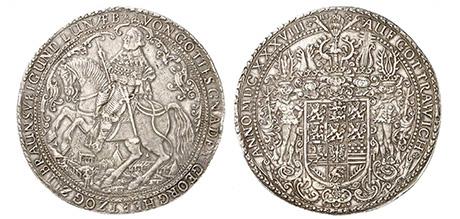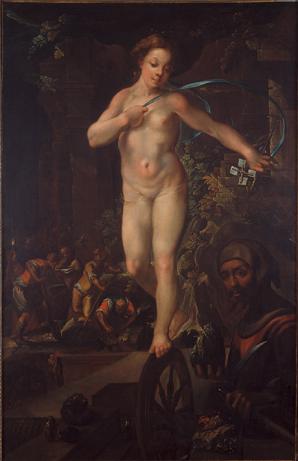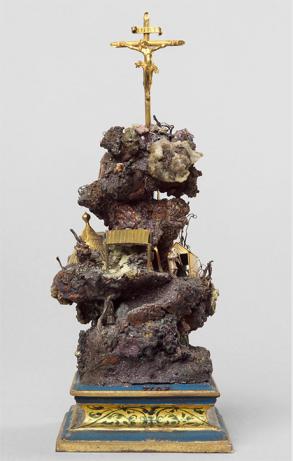Mining was one of the most important driving forces behind economic and technological dynamics in early modern Europe. Silver, copper, and lead mining experienced a veritable boom in the Ore Mountains, the Harz Mountains, and the Tyrolean Alps from the second half of the fifteenth century. The rapid spread of news of the discovery of rich metal deposits led to a sudden transformation of hitherto uncultivated areas into populated and prospering mining regions (Figure 1). The term “Berggeschrey,” or “mountain clamor,” was coined by contemporaries to describe this phenomenon—firstly, it points to a process of economic dynamism, with faster cycles of booms and busts and the circulation of people, knowledge, materials, and money at a quickened pace. Secondly, the clamor’s intensity and impulsiveness marks the affective dimension of this early modern silver rush, driven by material desires, hope, and fear.
My research project "Subterranean Economies—Resource Flows and Metal Culture in Early Modern Mining" links up the history of political economy—broadly understood as the set of practices of making and exchanging value in a given culture—with questions about knowledge, agency, and meaning being raised within the histories of science and art. I investigate contemporary processes and practices of valuation of metals that are not just restricted to mere economic dimensions but acknowledge the complex semantics of the material and their emotional-affective implications. By looking more closely at the dynamic sociocultural energies behind the already well-studied economic and technological developments of the early modern mining industry, and by addressing the materiality and its transformation through mutual processes of appropriation and attribution, my research challenges teleological narratives of the consolidation of administrative structures, financial mechanisms, and technological innovation. Building upon people’s longing for precious and semi-precious metals, my leading questions center material and emotional valorizations of metals in connection with the manufacture and circulation of coin as a token of exchange and value.
The quickening of economic flows in and beyond mining regions led to widespread discussions, both in writing and practice, concerning the intrinsic value and exchange rates of coins. Since the greatest part of the mining region’s silver production was coined in local mints, mining was closely connected to monetary policy and practices. The increased silver output led to the leading gold currency (Rhenish guilder) being gradually replaced by a silver equivalent—the Guldiner, Guldengroschen, or Taler. The mints not only produced Taler coins, but also commemorative medals—such as that of Duke Georg of Braunschweig-Calenberg (Figure 2)—mining coins (Ausbeutemünzen), which served as payment for the investors (Gewerken) of a certain mine, and tokens. On a regular basis, new edicts were issued, new coins introduced, old coins valued or revalued, and “evil” coins with a very low precious metal content were prohibited. In these discourses the values of raw material, of utility, and of exchange overlapped with and were intimately linked to desires, wishful thinking, and moral discourses about honest and deceitful ways of making profit.

Fig. 2: The mines as an emblem of power. Schaustück (showpiece) of Duke Georg Braunschweig-Calenberg value of 4 talers. Henning Schlüter: Zellerfeld, 1638, 115,31g, 89mm.
The new possibilities for making fortunes—and losing them—triggered contemporary reflection on material wealth and financial profit, not only on the level of the state’s (o)economy but also for individuals who dared to invest. Contemporaries described the mountains as “matrices” of wealth and repositories of all treasures. With the aid of increasingly expensive machines, costly ventilation and drainage technologies tunnels were drilled into great depths, and with new metallurgical methods such as liquation, ores with poorer metal content could be exploited and processed. These developments turned mining industry into a high-risk and capital-intensive business, where people could easily lose money and ruin themselves. These technological and organizational innovations therefore not only changed the economic landscape, but affected people’s perceptions of metallic ores and the value attached to them. As the miners and investors believed, one could acquire the desired metals and turn the mining venture into profit by trusting in God and one’s good fortune, by having good hope, true skill, and adequate knowledge.
The association of mining with knowledge, wealth, risk, and uncertainty thus clearly connects the desire for material gain with a fear of financial wreck and loss, and situates them within a discourse of Christian virtue. A painting made by the German artist Matthäus Gundelach (1566–1653) offers a highly elaborate representation of this interconnection (Figure 3). This allegory depicts Fortuna balancing on a wheel that drives a winch for lifting materials from a shaft. On her right hand side a positively connoted miner, represented in his traditional dress, presents an ore specimen, on her left side a group of treasure hunters violently dig up the earth in search of a coin hoard. Gundelach created this painting in a time of hyperinflation and opposed artificial riches (coins) to natural riches and pits the learned and honest miner against ignorant, greedy, and reckless treasure hunters; however, he arranged both sides along the axis of chance. The visible confrontation between ores and coins link to broader questions about the relationship between natural wealth or natural riches and the production of value by “artificial” means, and furthermore whether art (or human labor in general) should have the power to multiply value.

Fig. 3: Men’s quest for natural riches: Fortuna, the good miner and the treasure hunters. Matthäus Gundelach, Allegory of Mining (ca. 1620). Oil on canvas, 133 × 86 cm. Dortmund, Museum für Kunst und Kulturgeschichte (inv. no. C 5188). Image © Museum für Kunst und Kulturgeschichte, Dortmund.
Not only in artworks, but also in texts and artefacts, do the mines appear as polyvalent spaces: the artistically crafted ore specimen (Handstein) made by Caspar Ulrich in Joachimstal presents the mine as divine treasure and repository of wealth (Figure 4). Furthermore, mines are represented as laboratories or workshops of technological and metallurgical knowledge and innovation, as important sites of courtly representation and emblems of the sovereign’s economic power (Figure 2), or as points of convergence for mutual material desires and risks. In order to encompass the complex semantics of the material, which integrate social, economic, epistemic, symbolic, and emotional dimensions, it is important to acknowledge religion as a fundamental structuring principle of early modern societies. For contemporary miners, and other people actively involved in the mining industry, the hope for rich yields was not just a mere material quest. Hope—alongside faith and love or charity—was also a Christian virtue that superimposed rational thinking with positive expectations about future happenings based on prognostications and confidence in God’s will. Hope means a longing for a happy end, which depends, in addition to knowledge and skill, upon divine providence.

Fig. 4: Handstein (piece of ore) with a mining scene representing the biblical mountain Golgotha. St. Joachimsthal, or Tyrol 1550. Kunsthistorisches Museum Wien, Kunstkammer Inv. No. 4167.
Clearly the materials in question—gold, silver, copper, lead, and iron—rather than being stable or fixed entities, functioned simultaneously as economic resources, scientific objects, or substances, raw materials, and powerful allegories as well as phantasms or images of value. This research project offers a new perspective of the early modern mining industry as a sociomaterial phenomenon in its own right—constituted by the entanglement of the actors’ economic practices and scientific techniques with meaning-making affects and desires.
